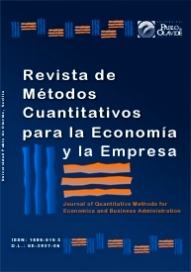Las Redes migratorias chinas en Europa y el equilibrio comercial
DOI:
https://doi.org/10.46661/rev.metodoscuant.econ.empresa.5423Palabras clave:
Migración, Redes Migratorias, Exportación, Importación, Balanza ComercialResumen
El objetivo de este trabajo es estimar el efecto de las redes migratorias chinas sobre su balanza comercial. Hemos medido el impacto sobre la exportación de la emigración china a los países europeos y lo hemos comparado con los efectos sobre la importación mediante la estimación de un modelo de gravedad en el que, además del PIB/Cápita, la distancia y otras variables ficticias, se incluyó la emigración como variable explicativa. Nuestros análisis, basados en una regresión GLS de panel de 32 socios comerciales europeos de China en 1960, 1970, 1980, 1990 y 2000, han revelado que el efecto de la emigración sobre la importación es ligeramente más importante que el efecto sobre la exportación. La principal conclusión del estudio es que un aumento del diez por ciento en la emigración de China a los países europeos disminuye el valor real de la balanza comercial en un 0,18 %.
Descargas
Citas
Bergstrand, J. H. (1985). The gravity equation in international trade: some microeconomic foundations and empirical evidence. The review of economics and statistics, 474-481.https://doi.org/10.2307/1925976
Combes, P., Lafourcade, M., & Mayer, T. (2003). The Trade Creating Effects of Business and Social Networks. Document de travail CERAS, (3750).
Djelti, S. (2017). Osmosis: the unifing theory of human migration. Revue Algérienne d'Economie et de management, 8(2), 48-59.
Djelti, S. (2016). Réseaux migratoires et balance commerciale: Évidence de l'Algérie. Revue Algérienne d'Economie et de Management, 7(2), 1-11.
Djelti, S. (2017). Osmosis: the unifing theory of human migration. Revue Algérienne d'Economie et de management, 8(2), 48-59.
Djelti, S. (2018). Osmosis of forced migration: The Plasmolysis Theorem" paperpresented in the United Nation University-Globalization, Culture and mobility. internal research workshop, UNU-GCM,, Barcelona, Spain. Retrieved from https://www.researchgate.net/publication/328248979_Osmosis_of_Forced_Migration_The_Plasmolysis_Theorem_1_Draft_Paper
Djelti, S., Ahmed, M. H., & Guellil, M. S. (2021). Migration networks and the Moroccan tourism: A panel data analysis. Revista de Métodos Cuantitativos para la Economía y la Empresa, 32, 130-147.https://doi.org/10.46661/revmetodoscuanteconempresa.4482
Djelti, S., & Zapata-Barrero, R. (2023). Transnational Migrant Entrepreneurship Policies in the Maghreb Countries: Tunisia, Algeria, and Morocco. In Migrations in the Mediterranean: IMISCOE Regional Reader . 403-418. Cham: Springer International Publi.https://doi.org/10.1007/978-3-031-42264-5_23
Ehrhart, H., Le Goff, M., & Singh, R. J. (2012). Does Migration Foster Exports?: An African Perspective (Vol. 38). CEPII.
Felbermayr, G. J., Jung, B., & Toubal, F. (2010). Ethnic networks, information, and international trade: Revisiting the evidence. Annals of Economics and Statistics/Annales d'Économie et de Statistique, 41-70.https://doi.org/10.2307/41219109
Gould (1991) "Immigrants Links to the House Country: Empirical Iimplications for U.S. and Canadian Bilateral Trade Flows" Federal Reserve Bank of Dallas, No: 91-02.
Gould, D. M. (1994). Immigrant links to the home country: empirical implications for US bilateral trade flows. The Review of Economics and Statistics, 302-316.https://doi.org/10.2307/2109884
Greif (1989) "Reputation and Coalitions in Medieval Trade: Evidence on the Maghribi' Traders Journal of Economic History XLIX.https://doi.org/10.1017/S0022050700009475
Greif (1993) "Contract Enforceability and Economic Institutions in Early Trade: The Maghribi Traders' Coalition" American Economic Review. 83:3, pp. 525-48.
Hiller (2011) "The Export Promoting Effect of Emigration: Evidence from Denmark" ETSG 2010, the Gottingen Workshop in International Economics.https://doi.org/10.2139/ssrn.1856504
Kugler, Rapoport (2011) "Migration, FDI, and the Margins of Trade" CID Working Paper N°222.
Lahmeri, H. (2024). Forecasting Migration Flows in the Mediterranean Countries: The Osmosis Model" PhD thesis. Economics Faculty, Mustapha Stambouli University.
Lahmeri, H., & Djelti, S. (2023). Innovation and Migration in the mediterranean Region during 1972-2017. Revue Organisation et travail, 12(1), 156-170.
McCallum, J. (1995). National borders matter: Canada-US regional trade patterns. The American economic review, 85(3), 615-623.
Rauch, Trindade (2002) "Migration Chinese Networks in International Trade" The Review of Economics and Statistics, Vol 84, N° 1.https://doi.org/10.1162/003465302317331955
Rauch, Casella (1998) "Overcoming Informational Barriers to International Resource Allocation: Prices and Group Ties" NBER Workong Paper Series, N° 6628.https://doi.org/10.3386/w6628
Redding, G. (2013). Governance in Pacific Asia: political economy and development from Japan to Burma.https://doi.org/10.1080/13602381.2013.789657
World trade report (2014) "Trade and development: recent trends and the role of the WTO" https://www.wto.org/english/res_e/booksp_e/world_trade_report14_e.pdf
Descargas
Publicado
Cómo citar
Número
Sección
Licencia
Derechos de autor 2024 Samir Djelti

Esta obra está bajo una licencia internacional Creative Commons Atribución-CompartirIgual 4.0.
El envío de un manuscrito a la Revista supone que el trabajo no ha sido publicado anteriormente (excepto en la forma de un abstract o como parte de una tesis), que no está bajo consideración para su publicación en ninguna otra revista o editorial y que, en caso de aceptación, los autores están conforme con la transferencia automática del copyright a la Revista para su publicación y difusión. Los autores retendrán los derechos de autor para usar y compartir su artículo con un uso personal, institucional o con fines docentes; igualmente retiene los derechos de patente, de marca registrada (en caso de que sean aplicables) o derechos morales de autor (incluyendo los datos de investigación).
Los artículos publicados en la Revista están sujetos a la licencia Creative Commons CC-BY-SA de tipo Reconocimiento-CompartirIgual. Se permite el uso comercial de la obra, reconociendo su autoría, y de las posibles obras derivadas, la distribución de las cuales se debe hacer con una licencia igual a la que regula la obra original.
Hasta el volumen 21 se ha estado empleando la versión de licencia CC-BY-SA 3.0 ES y se ha comenzado a usar la versión CC-BY-SA 4.0 desde el volumen 22.










